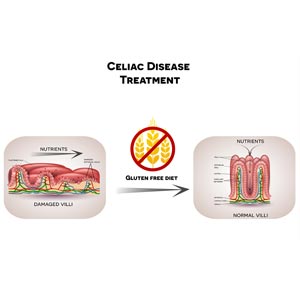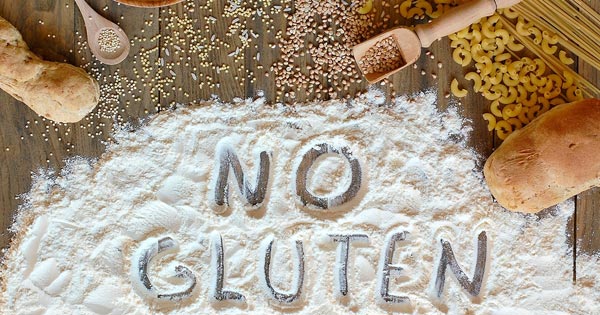Crush Your Aversion to Going Gluten-Free and Sticking with it!
by Erika Slater
In this article you’ll find discussions and answers to:
- Why you would want to go gluten-free and what it means?
- What’s Celiac Disease and intolerance to gluten?
- The challenges in going gluten-free and strategies for overcoming difficulties to stick with it.
- Further resources for help in becoming and staying gluten free.
Over the last 10 years there’s been a lot of talk about ‘gluten-free’ diets being healthier for you.
Conversely, gluten has been made a ‘culprit’ in leading to health issues for some people. So many processed and staple groceries people buy contain gluten.
If that isn’t enough, many people are ‘hooked’ on the products, partially because they’re habituated or addicted to gluten.
More and more health professionals are asking their patients to steer away from gluten products and start using healthier alternatives. For some, making this change is difficult for a myriad of reasons.
Is it really hard to go gluten-free, and why would you want to anyway?
WHY WOULD YOU GO GLUTEN-FREE AND WHY IS IT SO DIFFICULT?

Many people hear gluten is bad for them, but have no idea what it is exactly, or what ‘foods’ it’s found in.
Generally speaking, gluten is the name for the proteins found in wheat, semolina, spelt, rye, barley and triticale – which is a hybrid of rye and wheat. The purpose of this protein found in grains is to help foods maintain their ‘shape’, basically serving as a “glue” to help hold the food together.
I’ve been eating “glue” you may ask?
Well, in a way yes. But these are naturally occurring proteins in grains and so you’re not eating something you can use to put up a kitchen hanger or piece together some broken ceramics. Funny you may think.
However, for those with Celiac disease gluten is no joking matter and can damage their small intestine if consumed.
Gluten is found in many of the foods folks pick up at the grocery store and consume daily. They’re in what many people consider to be staple foods for the family meals. Some of the more common foods gluten can be found in are; breads, cereals, soups, pastas, salad dressings, beer, malts, food coloring’s, pastries, and many snack foods, etc.
Still more foods contain “hidden gluten” or gluten used in unexpected ways. So, it’s important to be vigilant when checking the ingredients on the packaging.
Why is gluten bad for so many people?
Consuming gluten can trigger symptoms of celiac disease.
Celiac disease can develop at any age after people start eating foods or medicines that contain gluten. It’s hereditary, meaning it runs in families.
Celiac causes inflammation in the body and also creates digestive issues and tissue damage to the small intestines. This results in a lot of discomfort for anyone who cannot tolerate gluten. They are likely to experience chronic headaches, skin rashes, swelling, diarrhea, bloating, tiredness, constipation and even depression.
Irritable Bowel Syndrome (IBS) is one of the more prevalent disorders individuals suffer from who have gluten allergies. It’s estimated one percent of the population suffers from it.
Gluten allergies are no laughing matter for people! It has tremendous implications for stress and requires serious lifestyle modifications.
For those individuals who suffer from these allergies, it’s a foregone conclusion they must eliminate gluten from their diets if they wish to feel good physically. But sometimes it’s difficult to eliminate the foods you love, almost like a smoker, or alcoholic, trying to give up their habit or addiction.
For more specific information on Celiac disease and other allergies, and what it means to go gluten-free please read the articles I’ve put in the resource section below at end of this post.
If you consider the foods we mentioned earlier containing gluten such as bread, pasta and cereals then these are what many as kids and adolescents grew up on! So, giving them up, or finding tasty substitutes will be hard, and even if you do find alternatives then sticking with the alternatives will also be difficult.
But it’s not impossible and this next section offers some help…
CHOOSING AND STICKING WITH YOUR GLUTEN-FREE DIET:

For example, we don’t east pasta in our household but a family member loves it but doesn’t eat a lot of vegetables, so we buy pasta made from vegetables such as zucchini and broccoli. It looks and tastes fine and satisfies the need to eat “pasta” – it really looks like it – and also achieves the other goal of eating more vegetables.
Buckwheat flour can also be used to make pasta and buckwheat is a great alternative to grains. Buckwheat can also be used to make breads.
Many bakeries today offer gluten-free breads.
If you have mild allergies to gluten then eating sprouted grain breads as alternative to white flour grain bread can help reduce reaction without substituting gluten altogether.
The main criticism leveled at gluten-free foods is… the taste.
The fact is they do taste different. But it has more to do with our expectations and habit tasting – I think I just made that term up – than the real taste. So, what do I mean?
You can get to a point where you accept and like a taste. It may take some time and dedication but eventually if your health matters enough to you, you can grow accustom to a different taste. For example, I always took cream in my coffee. Then I moved to whole milk and now onto less fat in my milk. Each change has thrown a new taste at me and so I’ve done it in steps.
Effectively, its taking the new food, or change in taste, long enough to form a new taste habit.
This is likely to be the same for most gluten-free alternatives you’ll find. Accept it will taste different and providing it doesn’t make you have an averse reaction then you’ll overcome it. Think more about what you’re giving to your body and less about what you’re giving up.
In neuroscience an effective strategy for overcoming thoughts that get in the way of you creating new positive habits is called pattern interrupt. I’ve written about the techniques associated with this strategy in an earlier article and put a link to it below in the resource section.
So, what do you do if you’re still struggling or in danger of not sticking to your gluten-free diet?
Hypnosis is a viable avenue to take if you’re looking to modify your eating habits and conquer your love of gluten-filled food products.
Hypnosis can do this in a few ways.
Two strategies for outcomes can be aversion and another is positive reinforcement.
Hypnosis can turn you off to certain foods containing gluten such as breads or cereals. A hypnotist can place in your unconscious mind suggestions to create aversions to these foods. Every time you think about them or see them, you’ll not want them. In fact, the thought of them creates a negative emotional reaction – sometimes even physical.
Hypnosis can also be used to reinforce eating healthy gluten-free foods by creating a positive emotional reaction supporting your consumption of them, and speeding up the acceptance of them for you, and of course helping you stick to your diet. My own weight loss hypnosis service program helps people stay on their diet whatever they chose.
Regardless of whether you go down the hypnosis path of aversion or positive reinforcement, the Gluten problem is solved quicker for you.
Let’s do a recap for you…
CONCLUSIONS
Gluten-free products are available these days in most supermarkets. This has come about because of the demand and number of people that must eat gluten-free because they’re allergic to foods containing gluten, or because it’s a choice to avoid grains which our bodies have trouble digesting.
Gluten-free products do taste different and for some folks sticking to such a diet can be troublesome and challenging.
Our taste buds can be acclimatized to different tastes and it tends to be food association that impedes us in acceptance. For example, pasta has distant shapes and when it doesn’t taste the way we expect for that shape then it makes it more difficult for us to stay the course. However, we can interrupt this thought pattern by using various strategies and one of them is hypnosis.
Hypnosis can help cause aversions to gluten-filled foods, or create reinforcement in our unconscious for healthy gluten-free foods. It can also speed up the acceptance process.
ADDITIONAL RESOURCES RELATED TO GLUTEN-FREE:
Why is it So Darn Hard to Lose Weight? And Keep It Off! >>>
Why is it So Darn Hard to Overcome Sugar Addiction? >>>
Introduction to Emotional Eating Disorder >>>
The Most Important Secrets to Permanent Weight Loss >>>
What is Orthorexia and How to Overcome it >>>
Short Program Sugar Addiction Hypnosis Service >>>
All About Fat Loss and Benefits of Red-Light Therapy >>>
Erika Slater CH
Free At Last Hypnosis
Massachusetts
CATEGORIES
FEATURED POSTS
Interested in making a significant change in your life and interested in learning more about what I do and how I do it? Discover my hypnotherapy services here or contact me here.

DISCOVER HOW TO START CHANGING HABITS TODAY.
In this free audio hypnosis session, you’ll experience the power of your subconscious mind to begin to change your habits. If you've never experienced hypnosis before then this is a great introduction...


